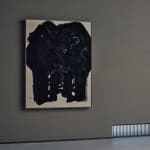Okabe Sōfū (1910–2001)
Work 47-8 (Primal Field)
Ink on paper, framed
Seal: So
131 x 100 cm
133 x 102 cm (overall)
Further images
Moji-sei, the fact of characters having semantic meaning, is the most problematic aspect of their art for avant-garde calligraphers. Within the debate among calligraphers if characters should be completely divorced from semantic meaning, Okabe Sofu argued that no matter if the artist embraced the aspect of meaning or rather the character’s pictorial quality, all this discussion centered solely on the creator’s side, disregarding the viewer of the work. Okabe suggested the concept of sho-sei (literally, the quality of being calligraphic), according to which any work could be regarded as avant-garde calligraphy if it was imbued with an aura of calligraphy. To judge this would be the task of the viewer. Though the viewer has no direct role in the process of artistic creation, the idea of an interdependence and balance between artist and viewer was novel back at that time.
Work 47-8 (Primal Field) is permeated by a sense of resolution created by Okabe’s brushstrokes of varying tones of black. He introduces a notion of movement that appears without hesitation yet is anchored in a powerfully structured composition. Doubtlessly a nonfigurative work, there is nevertheless an awareness of line, stroke and the dripping of ink that suggests the rhythmicality of calligraphy. Like various other Okabe works, the present effort also evokes a relationship to abstract painting that fluctuates between attraction and repulsion. In the postwar era, Japanese calligraphers had to come to terms with Abstract Expressionism, which they often considered an invasive presence. The title might hint at Okabe’s thought. Gen of the second character in brackets (in the original Japanese title) can be interpreted as the field of calligraphy being the origin of a nurturing, providing and eternal entity, from where Okabe believed the future of calligraphy lied in the understanding of the tradition and the past.
Within Okabe’s oeuvre, works titled by number appear in the latter half of the 1950s. This group can be divided further: titles referencing the Western calendar and those including Okabe’s age. Work 47-8 adopts the latter notation, that is, it was done at the age of forty-seven, the year of 1957.
Concerning its provenance, inside sources concur that this work was previously owned by a private collector in the United States, purchased after Okabe’s solo show at Mi Chou Gallery, New York, in 1966. Accordingly, Work 47-8 (Primal Field) was possibly on display at Mi Chou Gallery. Also, considering the production year of 1957 together with the fact that Okabe had been frequently invited to overseas exhibitions since the early 1950s, it is possible that Okabe created the present work specifically for the major touring exhibition Japanese and American Watercolors, held in various cities in the United States in 1957.
Okabe Sofu (calligrapher; 1910–2001)
Calligrapher from Gunma Prefecture. Okabe studied with Hidai Tenrai, and together with Ikeda Suijo established the Sojinsha art association. After leaving Sojinsha, Okabe found the Soro group (later Sorosha), directing his efforts to teaching the younger generation. He participated in numerous international exhibitions.
Work 47-8 (Primal Field) is permeated by a sense of resolution created by Okabe’s brushstrokes of varying tones of black. He introduces a notion of movement that appears without hesitation yet is anchored in a powerfully structured composition. Doubtlessly a nonfigurative work, there is nevertheless an awareness of line, stroke and the dripping of ink that suggests the rhythmicality of calligraphy. Like various other Okabe works, the present effort also evokes a relationship to abstract painting that fluctuates between attraction and repulsion. In the postwar era, Japanese calligraphers had to come to terms with Abstract Expressionism, which they often considered an invasive presence. The title might hint at Okabe’s thought. Gen of the second character in brackets (in the original Japanese title) can be interpreted as the field of calligraphy being the origin of a nurturing, providing and eternal entity, from where Okabe believed the future of calligraphy lied in the understanding of the tradition and the past.
Within Okabe’s oeuvre, works titled by number appear in the latter half of the 1950s. This group can be divided further: titles referencing the Western calendar and those including Okabe’s age. Work 47-8 adopts the latter notation, that is, it was done at the age of forty-seven, the year of 1957.
Concerning its provenance, inside sources concur that this work was previously owned by a private collector in the United States, purchased after Okabe’s solo show at Mi Chou Gallery, New York, in 1966. Accordingly, Work 47-8 (Primal Field) was possibly on display at Mi Chou Gallery. Also, considering the production year of 1957 together with the fact that Okabe had been frequently invited to overseas exhibitions since the early 1950s, it is possible that Okabe created the present work specifically for the major touring exhibition Japanese and American Watercolors, held in various cities in the United States in 1957.
Okabe Sofu (calligrapher; 1910–2001)
Calligrapher from Gunma Prefecture. Okabe studied with Hidai Tenrai, and together with Ikeda Suijo established the Sojinsha art association. After leaving Sojinsha, Okabe found the Soro group (later Sorosha), directing his efforts to teaching the younger generation. He participated in numerous international exhibitions.





